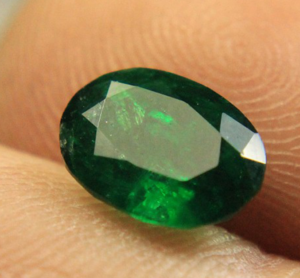Zamurd Stone: A Potential Gemstone Industry In GB
Junaid Ali Khan
Islamabad: The relationship between man and stone is centuries old. Man has made a journey from the Stone Age to today’s modern age. It was a stone through which man learned to make fire to ward off the cold and also used it as jewellery.
Civilisations are witnesses to the fact that man has used stones for jewellery in every age. Pakistan is also a country rich in countless resources, from its fertile soil to its water resources and four seasons, and few countries in the world have been blessed with such wealth as mineral reserves. These resources include rare, precious, and semi-precious stones.
Its mining patronage at the government level can increase the country’s foreign exchange
Man has not only used these stones for jewellery, but now they are also traded as the businessmen involved in this industry are trying to make it profitable through innovative methods.
According to a report published by the Ministry of Planning and Development in 2019 on the mining of precious stones in Gilgit-Baltistan, 30 types of precious and semi-precious stones are found in the northern regions of Pakistan, including emerald (Zamurd), ruby, topaz, and jade.
The annual production of these stones is 450,200 metric tonnes. These precious stones are mostly mined from the Himalayas, Karakoram, and Hindu Kush in the northern regions, which are in good demand at the national and international levels.

One of these precious stones is the stone ‘Zamurd’ which is found in large numbers at Shigar near the Skardu area of GB, but its mining is not among the government’s priorities. The local population mines it on a small scale by themselves and then trades it for a variety of items.
A few people from the town of Shigar have started to make ornaments, utensils, and decorative items from this stone. Locals and foreigners alike love this stone product.
Like the precious and semi-precious stones found in northern regions, Zamurd is also a precious stone that is abundantly found in sugar. Different types of things are made by carving this stone. These range from common food items to items used as ornaments or decorations.
A Zamurd tea set consists of six bowls, six leaves, sugarcane, a milk jug, a teapot, and a kettle. It is sold for Rs35,000. A water set consists of a jug and six glasses, which are sold for Rs32,000, while a bangle costs 12,000, earrings 800, a pendant 300-500, and a ring costs up to Rs500.
Jameel Abbas, associated with the business of Zamurd, says that its example is like the precious stone ‘turquoise’ used in rings; everyone wants to wear this stone ring because it is very attractive to look at. Zamurd is also loved by people for its precious green colour and attractiveness, and its enthusiasts want to wear it as jewellery, buy decorative products made from it, or drink water and tea made from it.

The use of this precious stone is not limited to jewellery or decoration; it is also known to neutralise snake venom. Rare, precious, attractive, and effective in reducing the effect of snake venom are the properties of Zamurd that make customers interested in buying it, but due to a lack of government patronage and support in this industry, this precious stone could not be utilised.
A member of the Pakistan Gemstone and Mineral Association says that people dig for Zamurd with their own help, but nothing can be said definitively about its production. If the mining and utilisation of this found stone are arranged, its industry can be promoted at the national and international levels.
Opposition Leader in the GB Assembly Amjad Hussain said that there are immense resources of precious reserves in Baltistan, including Zamurd, but due to the non-recognition of the authority of the province over the resources of the province, it is impossible to benefit from the reserves here.
There is an urgent need to conduct geological surveys and introduce modern industrial methods in order to utilise Zamurd and other mineral deposits. The role of the Rupani Foundation is very important for skilling the youth in GB. This foundation focuses on the polishing and cutting of precious stones.

Comments are closed.